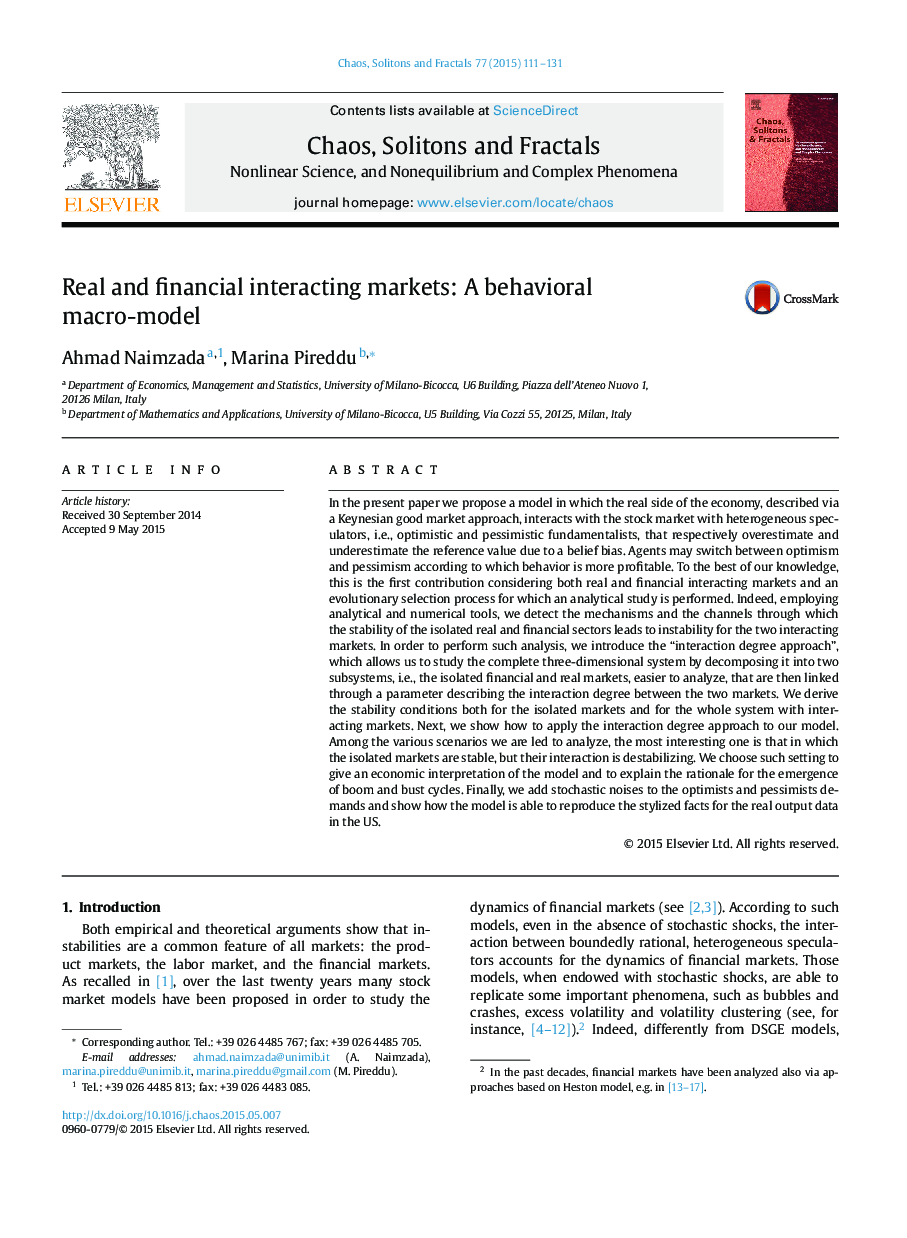| کد مقاله | کد نشریه | سال انتشار | مقاله انگلیسی | نسخه تمام متن |
|---|---|---|---|---|
| 8254840 | 1533647 | 2015 | 21 صفحه PDF | دانلود رایگان |
عنوان انگلیسی مقاله ISI
Real and financial interacting markets: A behavioral macro-model
ترجمه فارسی عنوان
بازارهای تعامل واقعی و مالی: یک مدل کلیدی رفتاری
دانلود مقاله + سفارش ترجمه
دانلود مقاله ISI انگلیسی
رایگان برای ایرانیان
ترجمه چکیده
در مقاله حاضر ما یک مدل را پیشنهاد می کنیم که در آن طرف واقعی اقتصاد، که از طریق یک روش بازار خوب کینزی توصیف می شود، با بازار سهام با دلالان ناهمگن، یعنی بنیادگرایان خوش بینانه و بدبین، که به طور معنی داری ارزش مرجع به یک تعصب اعتقادی. نمایندگان ممکن است بین خوش بینی و بدبینی تغییر کنند که طبق آن رفتار سودآورتر است. برای کسب اطلاعات بیشتر، این اولین سهم در نظر گرفتن بازارهای واقعی تعاملات واقعی و مالی و فرآیند انتخاب تکاملی است که برای آن یک مطالعه تحلیلی انجام می شود. در واقع، با استفاده از ابزارهای تحلیلی و عددی، ما مکانیزم ها و کانال هایی را شناسایی می کنیم که از طریق آن ثبات بخش های واقعی و مالی منحصر به فرد باعث بی ثباتی برای دو بازار متداول می شود. برای انجام چنین تحلیلی، ما یک رویکرد درجه تعامل را معرفی می کنیم که به ما امکان می دهد تا سیستم کامل سه بعدی را با تجزیه آن به دو زیر سیستم، یعنی بازارهای جداگانه مالی و واقعی، تجزیه و تحلیل آسان تر، که سپس از طریق یک پارامتر توصیف درجه تعامل بین دو بازار ارتباط دارد. ما شرایط ثبات را برای بازارهای منزوی و برای کل سیستم با بازارهای تعاملی به ارمغان می آوریم. بعد، ما نشان می دهیم که چگونه رویکرد درجه تعامل را به مدل ما اعمال کنیم. از میان سناریوهای مختلفی که منجر به تجزیه و تحلیل می شود، جالب ترین آن این است که بازار های جدا شده پایدار هستند، اما تعامل آنها بی ثبات است. ما چنین شرایطی را برای تفسیر اقتصادی از مدل انتخاب می کنیم و دلیل منطقی برای ظهور چرخه های رونق و انفجار را توضیح می دهیم. در نهایت، ما صداهای استوفا را به خواسته های خوش بینانه و بدبینانه اضافه می کنیم و نشان می دهیم که چگونه این مدل قادر به تولید حقایق تلطیف شده برای داده های خروجی واقعی در ایالات متحده است.
موضوعات مرتبط
مهندسی و علوم پایه
فیزیک و نجوم
فیزیک آماری و غیرخطی
چکیده انگلیسی
In the present paper we propose a model in which the real side of the economy, described via a Keynesian good market approach, interacts with the stock market with heterogeneous speculators, i.e., optimistic and pessimistic fundamentalists, that respectively overestimate and underestimate the reference value due to a belief bias. Agents may switch between optimism and pessimism according to which behavior is more profitable. To the best of our knowledge, this is the first contribution considering both real and financial interacting markets and an evolutionary selection process for which an analytical study is performed. Indeed, employing analytical and numerical tools, we detect the mechanisms and the channels through which the stability of the isolated real and financial sectors leads to instability for the two interacting markets. In order to perform such analysis, we introduce the “interaction degree approach”, which allows us to study the complete three-dimensional system by decomposing it into two subsystems, i.e., the isolated financial and real markets, easier to analyze, that are then linked through a parameter describing the interaction degree between the two markets. We derive the stability conditions both for the isolated markets and for the whole system with interacting markets. Next, we show how to apply the interaction degree approach to our model. Among the various scenarios we are led to analyze, the most interesting one is that in which the isolated markets are stable, but their interaction is destabilizing. We choose such setting to give an economic interpretation of the model and to explain the rationale for the emergence of boom and bust cycles. Finally, we add stochastic noises to the optimists and pessimists demands and show how the model is able to reproduce the stylized facts for the real output data in the US.
ناشر
Database: Elsevier - ScienceDirect (ساینس دایرکت)
Journal: Chaos, Solitons & Fractals - Volume 77, August 2015, Pages 111-131
Journal: Chaos, Solitons & Fractals - Volume 77, August 2015, Pages 111-131
نویسندگان
Ahmad Naimzada, Marina Pireddu,
